Click To Call > (800) 966-7673

Out of approximately 4,000 known species of cockroaches worldwide, 30 are associated with human habitations and about five are frequent pests in Michigan, Ohio and Indiana.
It is important to know which cockroach you are dealing with. Different species live in different habitats, behave very differently, and prefer different foods. Each species requires unique techniques to eliminate them. Believe it or not some species aren’t even considered pests as they don’t live and reproduce inside of human structures! The following graphic shows some of the more commonly encountered species and their relative size. Remember that all cockroaches start life as an egg, so immatures will be much smaller than the pictured adults and won’t have wings.

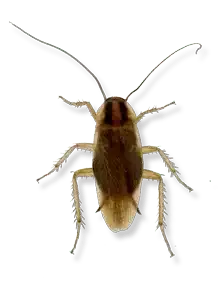
German Cockroach - Adults are 1/2 to 5/8 of an inch long, are light brown to tan in color and have a pair of dark “racing” stripes behind the head. As with most insect pests, the cockroach is a prolific breeder. Females produce egg cases with 30-40 eggs in them, and will produce about 5 egg capsules in their lifetime! They are commonly found infesting kitchens especially under warm appliances, such as ovens, refrigerators, and dishwashers. This species does not fly, despite their well-developed wings.
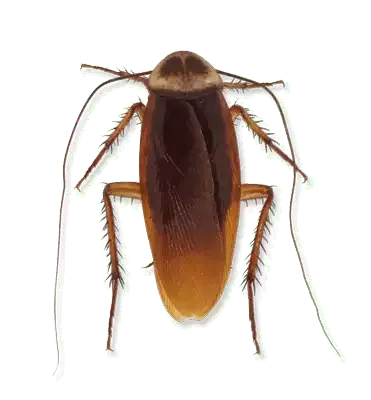
American Cockroach - Adults are 1 3/8 to 2 inches in length and reddish-brown in color with a light color surrounding a central darker marking on the plate behind their head. It is the largest of the common roaches and is capable of flight. They live a long time (for a cockroach) taking anywhere from 6 months to 2 years to mature, and living for another year or so after maturity. In other words, these things don’t just infest a structure overnight, but they do heavily populate warm moist areas like sewer systems and steam tunnels in the North. If many American cockroaches are suddenly noticed it’s a safe bet that a nearby sewer pipe has broken or a plumbing trap has dried out, giving them access to the structure.
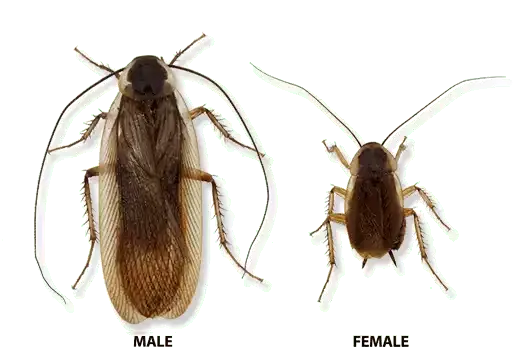
Pennsylvania Wood Cockroach - Males and females look quite different in this species. Adult males are medium sized and fully winged, often about 1 inch in length. The females are only 1/2 - 3/4 inches in length and have much shorter wings. This is a native cockroach to the Eastern U.S. and is rarely a pest, as it doesn’t reproduce indoors. However, in some areas, they can be quite common outdoors and the males will fly to lights left on at night, so they may occasionally be found indoors. This species may be found in wood piles, backed-up rain gutters, and wooden shingles or siding.
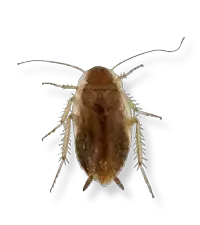
Spotted Mediterranean Cockroach – This is a very small cockroach, about 1/3 of an inch in length and a light tan color with darker speckles. This species is a more recent invader from Europe (introduced in the mid-1900's) and has been dramatically expanding its range ever since. It can now be found throughout Michigan and is quite common on outdoor foliage in some areas. This is another species that isn’t likely to reproduce indoors, but rather, they occasionally enter from outside. They are attracted to lights in the evening and will fly to them.
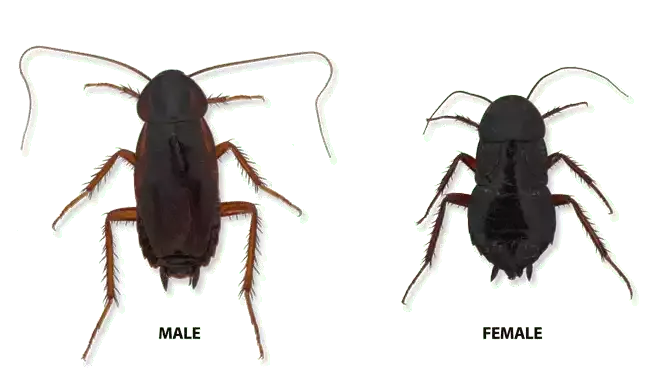
Oriental Cockroach - Adults are 1 –1 1/4 inches in length, dark brown or black in color. The females never develop wings, and the wings of the male only cover about 3/4 of their body. In our region, their biology is similar to American cockroaches, and they most frequently infest sewers and older buildings in downtown areas. However Oriental cockroaches are more cold-hardy and can occasionally infest outdoor locations where they will feed on filth such as garbage, feces, and other decaying organic matter.
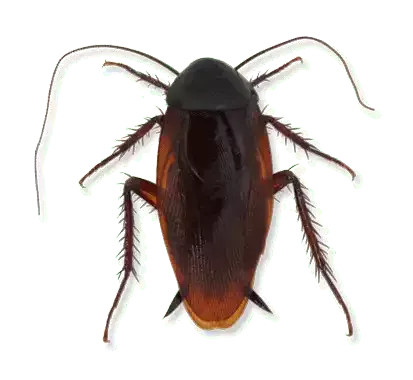
Smokeybrown Cockroach - Adults are approx. 1 – 1 1/2 of an inch in length and a deep, shiny, reddish-brown color. This species is very common down South but infrequently encountered in Indiana, Ohio, and Michigan. Oftentimes if they appear they may have hitched a ride on a shipment from a more Southern State. It can be recognized from the other larger cockroaches by adults having full wings (unlike the Oriental) and being one color (unlike the American).
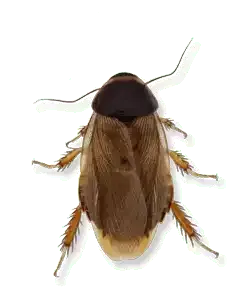
Surinam Cockroach – About 3/4 of an inch in length with a solid, dark plate behind their head with light tan-colored wings. This cockroach likes a warmer climate and will not be found outdoors in the North. They are uncommon to encounter, but when they are found it’s generally in a greenhouse or an atrium with many potted plants. Interestingly, all Surinam cockroaches are females, males are not known for the species, and females hold their egg case internally until it hatches so they appear to give live birth!
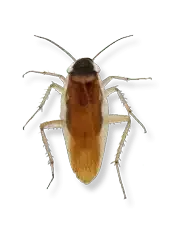
Brown-Banded Cockroach - Adults are approx. 1/2 of an inch in length and tan to light brown in color. Because of their similar size, they are sometimes confused as German cockroaches but have a solid dark brown mark behind their head instead of the “racing” stripes that the German has. This species is rather uncommon these days but will infest structures.
This will depend a lot on what species you are seeing, they may be coming in from outdoors, from the sewer, or brought in on an infested item. If you see one it doesn’t necessarily indicate a problem, however, if many are found there is almost certainly a problem! Generally, the pest species breed prolifically under the right conditions.
As a rule of thumb, the more cockroaches you are sharing your living space with the greater the potential for disease and other medical complications. In general, cockroaches are not dangerous. They won’t bite or sting. A number of species are kept as pets and used as pet animal feeds for many reptiles. However, cockroaches have been connected with outbreaks of illness such as salmonella poisoning and can instigate asthma attacks in allergic individuals. Cockroaches that thrive in human waste and garbage often carry various bacterial and viral pathogens on their bodies and deposit them in their feces. These species will readily contaminate nearby food and food-preparation areas which can result in food poisoning, diarrhea, or dysentery.
The species that infest our structures often thrive in areas of poor housekeeping. Being vigilant about cleaning dirty dishes, removing all food crumbs, and keeping trash areas clean will help. But getting rid of cockroaches is a difficult task due to their elusive, nocturnal nature and ability to thrive with very few resources, as many Do-It-Yourselfers will testify. That's why Rose Pest Solutions, along with our Entomologists, train our employees to efficiently find and eradicate cockroach infestations using the latest technologies and product formulations. The inspection and treatment process can be complex and time-consuming, but cockroaches can be eliminated in even the most challenging environments with time and effort. Pesticide use is almost always necessary to help eradicate a cockroach infestation, which requires care, precision, and following all label directions.
Rose Pest Solutions uses a variety of products and techniques to control cockroach problems, including, in many cases, non-toxic methods for monitoring and removal. All insecticides that Rose uses have been subjected to stringent tests and registered for use by the EPA for use against these pests. Generally, the products used against cockroaches indoors are minimally toxic and of little concern to health and safety. Please don’t hesitate to ask us if there are any specific questions about the treatment, your health and safety are always a top priority to us!
Cockroach problems can be very difficult to prevent. You can, however, make life significantly more difficult for cockroaches by ensuring that susceptible areas are kept clean and dry. Monitors can be used to give an early warning should cockroaches infest your space again in the future. For outdoor living species, periodic treatments can limit their populations.
Michigan Department of Agriculture - Questions and answers about cockroaches
Michigan State University - How to prevent and get rid of cockroaches in your home: Part 1
Michigan State University - How to prevent and get rid of cockroaches in your home: Part 2

With the Rose Home Service program, you pay one annual price and receive 12 months of protection. It's guaranteed to protect your home against common household pests. Our home service program includes pre-scheduled interior and exterior services over a 12-month period. If additional visits are needed, we will come out at no charge to you – it’s part of our guarantee to keep your home pest-free!